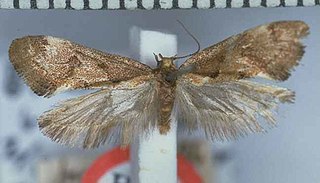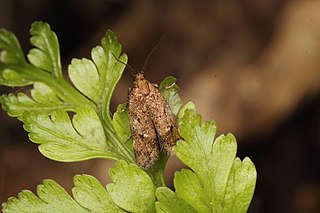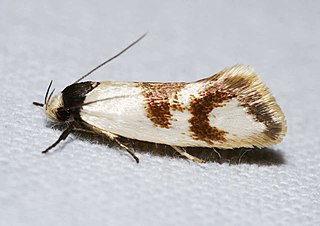Related Research Articles

Tymbophora is a monotypic genus of moth in the family Xyloryctidae. Its sole species is Tymbophora peltastis, which is found in most of Australia.

Mesapamea secalis, the common rustic, is a moth of the family Noctuidae. The species was first described by Carl Linnaeus in his 1758 10th edition of Systema Naturae. It is found in Europe, north-west Africa, Turkey and northern Iran.

Apamea scolopacina, the slender brindle, is a moth of the family Noctuidae. The species was first described by Eugenius Johann Christoph Esper in 1788. It is found across the Palearctic realm from central Europe to the Kuril Islands northeast of Japan.

Glaucocharis chrysochyta is a species of moth in the family Crambidae. This species was first described by Edward Meyrick in 1882. It is endemic to New Zealand and is found throughout the country. It inhabits native forest. Larvae appear to feed on moss and likely pupate there. Adult moths are on the wing from November to March. They fly at night and are attracted to light.

Hellinsia tinctus is a moth of the family Pterophoridae. It is found in Arizona and Mexico.

Amblyptilia epotis is a moth of the family Pterophoridae. It is endemic to New Zealand and is found in the South and Stewart Islands. It inhabits mountainous terrain covered in alpine vegetation or alternatively alpine wetland habitat. The adults of this species are on the wing from February to March. In appearance the adults of this species are variable in colour however this species can be distinguished from similar species by the oblique apical streak on its forewings as well as the patch of white on the costa cilia towards the apex of the forewing.
Glyphipterix haworthana, Haworth's glyphipterid moth, is a moth of the family Glyphipterigidae. It is found in most of Europe, as well as North America.
Neophylarcha helicosema is a moth in the Copromorphidae family, and the only species in the genus Neophylarcha. It is found in Guyana and French Guiana.

Apoctena orthocopa, also known as striped ponga leaf-tyer, is a species of moth of the family Tortricidae. It is endemic to New Zealand, where it is found only on the North Island.

Eucosma cana, the hoary bell, is a species of moth of the family Tortricidae.
Pexicopia dictyomorpha is a moth of the family Gelechiidae. It was described by Oswald Bertram Lower in 1900. It is found in Australia, where it has been recorded from New South Wales.
Antaeotricha constricta is a species of moth of the family Depressariidae. It is found in Colombia.
Antaeotricha walchiana is a moth of the family Depressariidae. It is found in Venezuela, Panama, Trinidad, Colombia, French Guiana, Brazil, Bolivia and Peru.
Antaeotricha bicolor is a species of moth of the family Depressariidae. It is found in Brazil.
Synchalara minax is a moth in the family Xyloryctidae. It was described by Edward Meyrick in 1907. It is found in India (Assam).
Eupselia syncapna is a moth in the family Depressariidae. It was described by Edward Meyrick in 1920. It is found in Australia, where it has been recorded from Queensland.

Tingena ancogramma is a species of moth in the family Oecophoridae. It is endemic to New Zealand and has been found in the Hen and Chicken Islands, the North Island and the South Island. Adults are on the wing in summer and autumn and inhabit open areas of forest scrubland.

Tingena brachyacma is a species of moth in the family Oecophoridae. It is endemic to New Zealand and has been found in the south of the South Island. This species inhabits open swamps, native forest and scrubland and has been collected amongst Leptospermum. The adults of the species are on the wing in November and December.

Tingena fenestrata is a species of moth in the family Oecophoridae. It is endemic to New Zealand and has been observed in the South Island. This species has been observed in native forest habitat in December.

Antipterna trilicella is a species of moth in the family Oecophoridae, first described by Edward Meyrick in 1885 as Ocystola trilicella. It appears to be a moth endemic to Australia and confined to the east coast, occurring in Victoria, New South Wales and Queensland.
References
- ↑ Descriptions of Australian Micro-lepidoptera. XVI. Tineidae. Proceedings of the Linnean Society of New South Wales 2-n.s. 7(4): 477-612; p. 603
 This article incorporates text from this source, which is in the public domain .
This article incorporates text from this source, which is in the public domain .